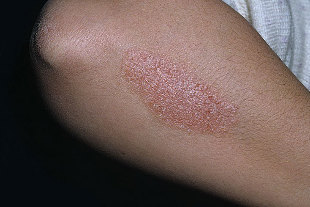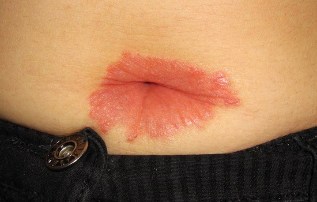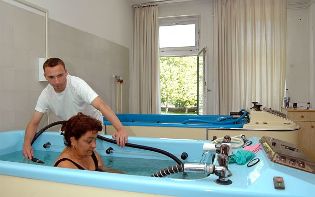Psoriasis belongs to dermatoses and is manifested unpleasant advanced acne on the body. It almost doesn't hurt, but strongly itching and unaesthetic appearance, and so they supply the person a lot of discomfort. Consider, what are the types of psoriasis, how they differ and how you can cure the disease .
Classification of psoriasis according to ICD-10

According to the international classification of diseases psoriasis assigned the code L40. This means, that refers to the papuloscentus disorders (from lat. papula - "nodule" and squama - "the scales").
L40.0 Psoriasis common
Other names: plaque-like. Diagnosed almost 90% of the sick. Manifested by papules scaly patterns. Plaques may have a gray, silver-white or pinkish color. Papules sometimes grow, connect with neighboring and formed in the whole of "islands" or "lake".
L40.1 Psoriasis pustular generalized
Other names: exudative, impetigo, the disease Tsumbush. It is considered the most severe form; manifested in bubbles or blisters, filled with an inflammatory substance - effusion. If the vial will reveal, and the inside gets infection, psoriasis acquires the festering character. Most of these blisters occur on the hands and feet, less often - on the body.
L40.2 Acrodermatitis durable
Other names: dermatitis Crocker, dermatitis Settona. The contents of the pustules (blisters), generated in this form of psoriasis, sterile, so acrodermatitis is not contagious. The main difficulty is in the fact that food stamps can form on the fingers, what can exfoliate the nails.
L40.3 Pustules of the palms and soles of the feet
Other names: pustular bactericide. According to the title it is clear that with this type of psoriasis affects the soles and palms. They are covered with large and small pustular bodies, which gradually grow and enlarges on the square. The contents of the pustules sterile, but pustular bactericide is considered a serious disease. Treatment is difficult, the blisters are constantly exposed to mechanical action (wear down and reveal while walking).

L40.4 Psoriasis teardrop
Manifests itself with small purple points, scattered on the hips, shins, forearms , shoulders, head, neck and back. Often develops after the transmission of strep a sore throat or the pharynx .
L40.5-7 arthropathic Psoriasis
Other names: psoriatic arthropathy, psoriatic arthritis. The disease affects about 10% of all patients with psoriasis. Affects the joints and connective tissue . Outwardly manifested by swelling of the phalanges of the fingers and toes. Less often affects the hip, humeroscapular, knee joints and spine. Sometimes leads to disability: the patient is not able to move.
L40.8 Other psoriasis
Other names: reverse psoriasis. Manifested by smooth inflamed patches, which are almost not the crust and localized in the folds of the skin and at the joints (in the groin, the elbows, the external genital organs, under the milk glands, etc.). Problems treatment other psoriasis due to the constant rubbing of the affected places, and also discharge sweating in the skin folds. Often reverse psoriasis is the cause of fungal infection.

L40.9 Psoriasis unspecified
This includes all the other forms of psoriasis that are not appropriate even under one of the above.
There is another division of the psoriasis on the categories according to the clinical classification.
According to the localization
Psoriatic plaques can spread to different parts of the body.
- The palms and soles of the feet. As has been found before, is it pustular bactericide (code L40.3).
- Joints . About psoriatic arthritis also talked (the code L40.5-7).
- Of the mucous membrane. The difficulties manifest themselves in the oral cavity, conjunctiva, and mucus of the genital organs. Education in the form of inflammatory elements of different shapes, but with clear boundaries. Around is a small swelling.
- Nails . Scientific name: psoriatic onychodystrophy. Symptomatology: deepening and dot on the surface of the nail, tarnish the nail plate, peeling, crumbling, the translucency of the capillaries, the itching near the skin.
- Hairy part of the head. This type is called seborrheic psoriasis. Many confuse with dandruff , because one of the symptoms is the flaking of the scalp. But seborrheic psoriasis much more uncomfortable disease, because it is the skin shatters also in the area of ear shells and can spread to the neck. All this accompanied by the strongest itching and bruises during the tearing of the scab .
- Large skin folds or intertrigio psoriasis. Plaque form between the toes, in the groin, in the armpits, under the breasts in women.
- The surface of the body. This phenomenon is called erythroderma. Form of this disease has a high percentage of lethal outcome , because of the defeat of the boards the skin loses its basic functions: temperature regulation, barrier protection, and so sp
- System defeat too dangerous, because it means a combination of several types of psoriasis.
According to the clinical picture
The manifestations of psoriasis becomes:
- common (vulgar);
- exudative;
- pustular;
- arthropathic;
- in the form of erythroderma.
Psoriatic erythroderma
The whole typology of the considered higher.
In the development stage
If we take into account psoriasis in terms of its staging , then one can distinguish several stages.
Progress psoriasis
Stage of maturation of the inflammation. Has the following symptoms:
- education pink smooth papules;
- itching;
- inflammatory reaction after irritation of papules (scratch, try to pierced with a needle or a toothpick, etc.);
- the beginning of the flaking of the individual elements.
Stationary psoriasis
Phase flows through almost unchanged:
- new papules are not formed;
- the old plaques is not increased in size;
- peeling of mild.
Retrogressive psoriasis

In the last stage, when wounds ingrown. Healing begins from the middle. On the site of the former food stamps are white depigmented patch, which is already out of stock no discomfort, in addition to the aesthetic component.
On the seasonality of the deterioration of the
For psoriasis is characterized by seasonal recurrence. In this regard, we distinguish:
- summer psoriasis: worsens by the action of sunlight;
- winter psoriasis; develops due to a severe cold, acting on the skin;
- off-season psoriasis: the most severe form of with a lack of a period of remission. Ie. the disease takes place year-round.
So it looks like the manifestations of psoriasis in summer form
On the square of skin lesions
In this classification only 2 types of psoriasis:
- limited - it takes less than 20% of the skin of the body;
- frequent - more than 20%;
- universal - struck by the whole skin cover.
The classification of the National fund (USA)
Psoriasis is different and the square losses:
- simple: beat up 2 % of the area of the skin;
- diameter: 2-10%;
- heavy: more than 10%.
According to the international index PASI
Table for the calculation of the index of slaughter with psoriasis
Index PASI seems to be a number from 0 to 72 and means the degree of severity of the occurrence of psoriasis from the weakest of clinical symptoms ( erythema and flaking) to severe (bruising, suppuration). The Index is defined by the experts.
Treatment of psoriasis
Modern strategy of treatment of the disease suggest the use of the whole complex of methods. While it is important to stick with three main objectives:
- to achieve rapid initial positive results;
- follow the ineffectiveness of some of the methodologies and cancel them, but continue to use what helps;
- pull the patient into remission.
Among the species of treatment of psoriasis issue two:
- non-drug;
- medically.
Non-drug treatment
If there is a possibility to do without drugs, doctors are always trying to use it. In the treatment of psoriasis significant role may play several factors non-drug therapy.The mode of the day
People who suffer from psoriasis, you need to:
- try to stop smoking;
- eliminate alcohol (even beer);
- wear clothes and sleep on the clothes only from natural fabrics;
- replace washing powder on the economic soap ;
- briefly cut the nails;
- only wash under the shower, to visit the baths and saunas;
- try to eliminate stress.
Diet with psoriasis
On the positive dynamics in the treatment of psoriasis good effect of low-protein diet restricting protein to 30 grams per day. Good results show the patients who once a week makes the handling. In this day you can eat 2-3 of tomato, a few leaves of lettuce, 1 cucumber, 2-3 cups of green tea and 300 ml of salt of soda.
The general principles of the diet plan foods with a psoriasis mean to you:
- freshly squeezed citrus juices;
- fresh or steamed vegetables;
- unsalted fish;
- pastries only from rye flour;
- dried fruit, fruit;
- nuts (not more than 50 g per day).
Also should limit or eliminate: meat, cereals, cold meats, sugar, potatoes, cheese, beans, oils, sweets, coffee.
Spa therapy

Spa therapy distracts by far not the last place in the treatment of psoriasis. This is great - the relapse factor.
To treat psoriasis can be in the Dead sea .The main plus balneotherapy: a force of nature in the fight with disease. Water treatments, a balanced diet, clean air and mild sun - all this will allow to reduce the symptoms of psoriasis and get off at remission.
Type of balneotherapy with varicose veins is the treatment of the fish Garra Rufus . These small creatures do not have teeth, but their lips gently eat up particles flaking skin and improve the microcirculation of the external skin cover. In addition, the procedure gives an excellent relaxing effect.
Physiotherapy
Between the physiotherapy methods in the struggle with psoriasis of the skin is used in the following:
- the uv radiation;
- selective phototherapy ;
- laser ;
- radiotherapy;
- cryotherapy (treatment with cold);
- electric;
- phonophoresis .
With the help of physiotherapy can achieve good aesthetic results, because almost all of the methods involve different kinds of effects on the skin outside. Food stamps are less, form healthy skin cells.
Photochemotherapy
This method is highlighted separately because it is one of the most effective in the treatment of psoriasis. It is used even in severe forms of the disease, which are poorly accessible to other physiotherapy procedures. Photochemotherapy consists in impact on skin long wave UVA radiation. Therefore, it is another name of the method - PUVA-therapy (PUVA) .
Treatment treatment
Treatment of psoriasis medicines also helps to relieve the main symptoms and send the patient on the road to recovery. One can distinguish three phases of the overall (systemic) pharmacologic treatments of psoriasis:
- Emergency therapy. Takes place in the period of acute course of the disease and is intended for the alleviation of acute symptoms. Of drugs use steroid medications and sometimes immunosuppressive drugs .
- A transitional phase. Means the gradual introduction of weak drugs that will in the future be accepted by the patient courses.
- Current supportive therapy.
Drug therapy includes the outdoor use of drugs:
- creams;
- foam;
- gels;
- lotions;
- ointment;
- spray.
Hormonal ointment on the basis of hydrocortisone, is used to treat psoriasis

Medication can be purchase or suggestions on the recipes of folk medicine. Means may stay out or under a closed bandage. The maximum effect in the treatment of psoriasis gives a combination of medication and non-drug therapy. All means and methods he picks up the doctor.
Conclusion
As you can see, the kinds and forms of psoriasis is very much, and determine what kind of disease is right for you, it is very difficult. Therefore, when the occurrence of the primary symptoms need to see a doctor, who will determine the type of psoriasis and prescribe appropriate treatment. The sooner you start fighting with psoriasis, the more effective and quicker will be the result.























